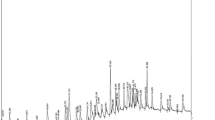Abstract
The fatty acid composition of the edible seeds from Pinus cembroides edulis (a nut pine), that might have been a commercial source of Δ5-olefinic acids in the United States, has been established. The dehulled seeds are rich in oil (64% by weight) and are characterized by high levels of both oleic and linoleic acids (ca. 47 and 41%, respectively), with only 10% of saturated acids. Δ5-Olefinic acids, which were not reported previously in this species, are exceptionally low as compared to most other conifer species: 5,9-18:2 acid, 0.1%; 5,9,12-18:3 acid, 0.4%; 5, 11, 14-20:3 acid, 0.3%. In this respect, P. cembroides edulis seed oil closely resembles that of P. pinea (a circum-Mediterranean species), which emphasizes the morphological and taxonomic relationship between the sections to which the two species belong (Parryana and Pinea, respectively).
Similar content being viewed by others
References
Takagi, T., and Y. Itabashi, cis-5 Olefinic Unusual Fatty Acids in Seed Lipids of Gymnospermae and Their Distribution in Triacylglycerols, Lipids 17:716–723 (1982).
Wolff, R.L., and C.C. Bayard, Fatty Acid Composition of Some Pine Seed Oils, J. Am. Oil Chem. Soc. 72:1043–1046 (1995).
Wolff, R.L., L.G. Deluc, and A.M. Marpeau, Conifer Seeds: Oil Content and Fatty Acid Composition. Ibid.:765–771 (1996).
Imbs, A.B., and L.Q. Pham, Fatty Acids and Triacylglycerols in Seeds of Pinaceae Species, Phytochem. 42:1051–1053 (1996).
Wolff, R.L., L.G. Deluc, A.M. Marpeau, and B. Comps, Chemotaxonomic Differentiation of Conifer Families and Genera Based on the Seed Oil Fatty Acid Compositions. Multivariate Analyses, Trees 11: in press (1997).
Wolff, R.L., New Tools to Explore Lipid Metabolism, INFORM 8:116–119 (1997).
Wolff, R.L., A.M. Marpeau, F.D. Gunstone, J. Bezard, M. Farines, J.C. Martin, and J. Dallongeville, Particularites Structurales et Physiologiques d’Huiles Nouvelles, les Huiles de Graines de Coniferes, Oléagineux, Corps gras, Lipides 5:65–70 (1997).
Sagrero-Nieves, L., Fatty Acid Composition of Mexican Pine Nut (Pinus cembroides) Oil from Three Seed Coat Phenotypes, J. Sci. Food Agric. 59:413–414 (1992).
Folch J., M. Lees, and G.M. Sloane-Stanley, A Simple Method for the Isolation and Purification of Total Lipids from Animal Tissues, J. Biol. Chem. 226:497–509 (1957).
Morrison, W.R., and L.M. Smith, Preparation of Fatty Acid Methyl Esters and Dimethylacetals from Lipids with Boron Trifluoride, J. Lipid Res. 5:600–608 (1964).
Berdeaux, O., and R.L. Wolff, Gas-Liquid Chromatography-Mass Spectrometry of the 4,4-Dimethyloxazoline Derivatives of Δ5-Unsaturated Polymethylene-Interrupted Fatty Acids from Conifer Seed Oils, J. Am. Oil Chem. Soc. 73:1323–1326 (1996).
Debazac, E.F., Manuel des Conifères, edited by Ecole Nationale des Eaux et Forêts, Nancy, France, 1964.
Author information
Authors and Affiliations
About this article
Cite this article
Wolff, R.L., Marpeau, A.M. Δ5-olefinic acids in the edible seeds of nut pines (Pinus cembroides edulis) from the United States. J Amer Oil Chem Soc 74, 613–614 (1997). https://doi.org/10.1007/s11746-997-0191-0
Received:
Accepted:
Issue Date:
DOI: https://doi.org/10.1007/s11746-997-0191-0



